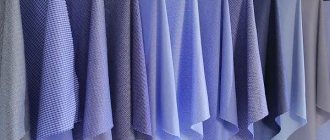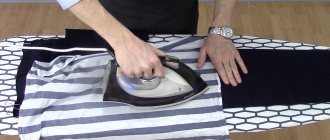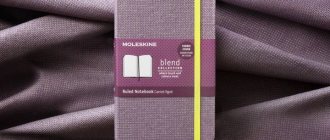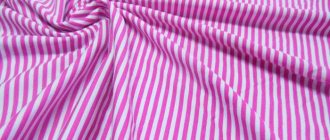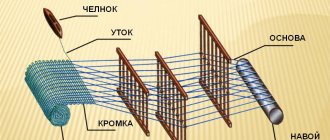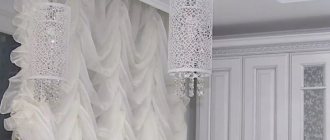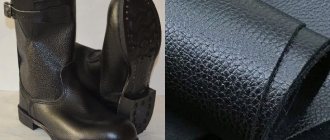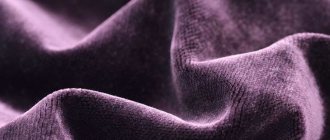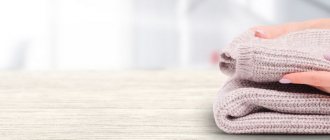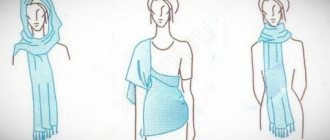Cashmere fabric is considered royal wool due to its rarity and unique properties: the material is especially thin and delicate, while being warm and cozy even in appearance.
Hypoallergenic luxury wool is used to sew basic wardrobes, underwear and children's clothing. We explain in detail in the article: what kind of material cashmere is and what you need to know about it.
Pink Mongolian Cashmere
What is cashmere and how is it made?
Cashmere fabric, also known as pashmina, is an expensive material made from the undercoat of mountain goats. It is particularly soft and tender, remaining warm, like other types of wool.
The material is produced strictly by hand, since the thin, delicate fibers are extremely valuable and require careful handling. Goats are combed once a year - in the spring, extracting about 200 grams of light fluff from one animal.
After this, the wool is processed, which reduces the volume of the material by half, and the output is a thin yarn, from which cashmere is made. It is the subtlety and labor intensity of the process, as well as the rarity of the raw materials, that elevate the fabric to the rank of one of the most expensive in the world.
Mountain Kashmir goat
Origin and history
The characteristics of the pile used to make natural cashmere are determined by the specific climate of the Himalayan mountains. Goats that provide valuable undercoat are bred only in India, Pakistan, Mongolia, China and Nepal. The name of the fabric comes from the province of the same name - Kashmir - located on the border of India and Pakistan.
Cashmere products have a fluffy “halo”
Residents of the Himalayan regions noticed the valuable properties of mountain wool back in the 16th century, realizing that thin and light things that can be created from goat hair provide excellent warmth even at very low temperatures.
Later, European colonialists learned what cashmere was, its composition (what the fabric was made of) and brought expensive products to the Old World, where cashmere immediately took its place on the shoulders of aristocratic people.
Delicate bedspread
Properties and features of cashmere fabric
Cashmere is the thinnest woolen fabric in the world; it is often used to make not only thick scarves, but also flowing stoles. Such a product can easily be passed through the gap of the ring. The material also has other distinctive qualities:
- Ease. Even cashmere coats are not burdened by ladies' and children's hangers.
- Strength and wear resistance. Cashmere lasts a long time without losing its shape and valuable properties.
- Thermal protection. The fabric warms well, holding a small air cushion, and also pleasantly massages the skin.
- Beautiful matte surface and smooth texture. Cashmere is distinguished by its elasticity, density, neat and elegant appearance. Due to this, it is often used for sewing elegant warm clothes.
- Flexibility. Thin products pleasantly fit the silhouette without creating rigid folds or creases or causing discomfort. Items made from pashmina do not wrinkle and, with careful care, do not stretch.
Note! A special feature of natural cashmere is its healing effect. According to research, the fabric has a positive effect on the joints and vascular system not only due to micro-massage of the skin, but also due to the goat wax contained in the hairs.
You might be interested in this: Features of Virginia wool, description of Lana cashmere fabric
It is advisable to protect the fabric from pungent odors, aggressive chemicals and moths.
Does cashmere pill?
Natural cashmere is characterized by increased strength and smoothness, and the structure of the delicate pile is such that the products do not break in. Synthetic things have this tendency, so if the product contains artificial additives, it may well become covered with small nodules over time. By whether the purchased cashmere pills, you can determine whether the item is truly made of elite material.
Snow white cashmere coat
Properties and composition of cashmere
Unique properties are determined by the raw materials from which the fabric is woven.
What is cashmere fabric made from?
The fluff of Kashmiri mountain goats is used for production. It is obtained manually , that is, the excess undercoat is combed out during the molting period. The most valuable raw material is considered to be the down of goats living in India and Mongolia.
The climatic features of the region contribute to the formation of undercoat with certain properties. Natural cashmere has a number of advantages:
- Low thermal conductivity. The hollow structure of the fibers retains air, which allows you to retain heat. The heat-protective properties are many times superior to wool.
- High strength. Despite the porous structure, the fibers are elastic and durable. It practically does not wrinkle and retains its shape well.
- Soft, delicate structure. Cashmere thread is many times thinner than silk and even human hair. It is soft and causes pleasant tactile sensations.
- High hygienic properties. Comfortable to wear, breathable, hygroscopic.
- Hypoallergenic. Natural fibers of animal origin do not cause itching or irritation of the skin.
Disadvantages include high cost and high maintenance requirements. In addition, pellets may form on the surface.
Color and dyeing features
Natural color indicates high quality. Goat down is weakly colored, the dyes quickly lose their brightness, so the fabric takes on a faded, slightly smoky shade.
Dyed fibers become less soft and elastic. Therefore, they try not to dye cashmere. Most often, the canvas retains its natural, slightly muted color . It matches the colors of Kashmiri goats: white, smoky gray, beige, dark brown.
What you need to know about the composition
Natural cashmere contains 100% goat down . To produce high-quality threads, the best raw materials are selected: long, thin fibers. Sometimes manufacturers use short, loosely twisted threads, which saves on the cost of raw materials.
As a result, the fabric retains increased softness, but becomes less dimensional stable. In addition, it is allowed to use cashmere thread with the addition of wool (20-40%).
Natural cashmere is an expensive material. To reduce cost, cashmere threads are mixed with different types of fibers. At the same time, a heterogeneous composition does not indicate low quality.
On the contrary, manufacturers are trying to improve some properties. For example, silk threads add shine and strength, and the addition of wool reduces pilling.
The composition of cashmere fabric in mass production is varied, the main components are :
- wool;
- silk;
- viscose;
- polyester;
- acrylic.
Recently, artificial fabrics imitating cashmere have become widespread. For their production, exclusively chemical fibers (polyester, acrylic, viscose) are used. In terms of aesthetic and hygienic properties, it bears little resemblance to natural.
Varieties
A beautiful word associated with luxury can mean several types of fabric:
Coat fabric
Cashmere is used to make outerwear, supplemented with other types of wool, such as alpaca. The finished products consist of only a third of the down component, but thanks to this they become very soft and warm. Additional fibers help protect the fabric from getting wet.
Eco-cashmere
Under the deceptive name with the “clean” prefix, there is a synthetic fabric that looks exactly like natural cashmere. Along with the advantages - reduced value and pleasant appearance - it also has several disadvantages: it heats less and stretches over time, changing the shape of the product.
Note! Less commonly, this name can be understood as 100% products made from unpainted natural material, presented in the premium segment.
The range of cashmere products can satisfy a wide variety of needs
Mongolian
Mongolian is the name given to hand-made cashmere from the provinces of China and Mongolia. The raw materials are processed with special care, and the end result is durable and especially durable items that do not lose their shape even after many washes.
Are pashmina and cashmere the same thing?
As a rule, pashmina is the raw material from which the fabric is made, and cashmere is a ready-made luxurious material. But these words can be considered synonyms and can be understood as both the undercoat of Himalayan goats and all products made from delicate fabric collectively.
The Europeans began to call the fabric cashmere, since it became legendary and recognizable, and its peculiarity was the place where rare wool was mined. The raw material was called pashmina in its homeland, so both names stuck on people’s lips.
Melange checkered color
Comparison with other fabrics
Natural cashmere is becoming less and less available. This is due to the reduction in the number of mountain goats and the difficulty of keeping them. It is much easier and more profitable to produce fabrics from the wool of sheep, camels, yaks, and merino sheep.
Cashmere is often compared to wool, although these threads and fabrics have different primary sources. Differences from wool:
- wool is produced from the hair of sheep, cashmere - only from goat down;
- when making woolen fabrics, wool and undercoat are used; only down is suitable for cashmere;
- Cashmere thread is much thinner and lighter than wool, but its heat-retaining properties are 8 times better than wool.
Which is better – cloth or cashmere
Cloth items are durable, strong, do not require special care, and retain their original appearance for a long time. Cashmere is more delicate, delicate, capricious, but it looks richer and more luxurious. Products made from cloth are coarser and more appropriate as outerwear.
Cashmere or drape
Drape is much heavier than cashmere, but more practical and lasts longer. Thanks to two-layer weaving, it has good heat-insulating properties. When visiting a theater, an exhibition, or going on a visit, it is better to wear cashmere items, while drape items will be appropriate for everyday wear.
Pashmina
This is a type of cashmere. For its production, fluff is used, combed from the belly or neck, which is soft and tender. Products made from pashmina have special markings and are priced higher than regular cashmere.
This fabric is used for the production of elite fabrics, stoles and is not used for sewing outerwear, as it quickly loses its appearance with friction and negative influences.
Online fashion show of fabric products in combination with others:
Application of material
Although the most famous cashmere products that have conquered the world are light coats and bright stoles, painted in oriental style, many more varieties of things are made from the rare material:
- bedspreads;
- scarves and shawls;
- socks and winter underwear;
- gloves, accessories and outerwear;
- sweaters, turtlenecks, vests and blouses;
- skirts, trousers and suits;
- children's clothing;
- dresses and many other products.
Note! Fine wool allows you to create delicate and sophisticated items that fit the figure and do not create any discomfort for the wearer.
Thanks to such unique properties, cashmere conquered the whole of Europe back in the middle of the last millennium; luxurious clothes and bedding were made from it.
Camel scarf
How to distinguish real cashmere from a synthetic fake
Often, under the guise of natural cashmere, they offer products obtained in a similar way, but created from more affordable types of pile. The quality of such items may not be inferior to the original, so for many who want to show off a luxurious product made from valuable material, buying a substitute becomes a profitable option.
You might be interested in this. Features of felt: what the fabric is made of and what can be sewn from it
You can’t always trust the description of the fabric composition on products, so you can determine whether the base is made from natural cashmere by the following signs:
- There is always a slight fluff on the surface of real cashmere wool, but synthetics will be much smoother.
- Artificial fibers have a characteristic creaking quality, which does not happen with wool.
- Real fabric is not electrified, which can be checked by rubbing it on a plastic surface and applying the item to your hair.
- When you pick up an item made from natural cashmere, you can feel a surge of warmth within just a few seconds, while synthetic fabric creates a warming effect for much longer.
- Pashmina has a pleasant matte color, while man-made fibers usually give a slight shine and shimmer in the light.
- A radical way to test is by fire. Synthetics quickly begin to melt even from an approaching flame, and also emit a plastic smell.
Note! When it comes to fibres, man-made cashmere tends to be more resilient than bouncy natural items. But knitted items may spring back due to the characteristics of the weave, not the threads themselves.
Headbands
Why is cashmere so faded?
Completely natural cashmere is not treated with any dyes, so its palette matches the color of mountain goats - from snow-white to brown-black shades. In order not to spoil valuable raw materials and preserve the beneficial properties of the fabric, the products are sold for sale in their natural form.
Application
Not every canvas can boast of being universal. But cashmere may well lay claim to this role. Almost any product can be sewn from it:
- berets,
- shawls,
- coat,
- cardigans,
- gloves,
- coat,
- skirts (cashmere knitwear),
- trousers (suit fabric is used).
There are various styles and models of clothing that both children and adults can try on. But most often a sweater is made from cashmere. It can even be seen on popular Hollywood stars, singers and politicians.
The video shows the characteristics of cashmere fabric:
Features of caring for cashmere products
In order for expensive fabric to retain its valuable properties for a long time and remain neat and pleasant to the body, it is necessary to ensure proper care of cashmere items:
- wash fabric only in cool water;
- do not use rough spin, including when washing by machine;
- use gel detergents, avoiding abrasives;
- dry the washed items by carefully laying them out on a cotton cloth or mesh, do not hang them by the shoulders or other edges;
- do not wear things so that they do not absorb body and environmental odors;
- If ironing is necessary, use steam devices without heating the product with an iron.
Note! Cashmere should be protected from moths by choosing cedar cabinets and using scented backings such as lavender.
Three-color stole
How to wash, clean and iron a coat?
If you clean your cashmere coat at home, you need to carefully study the composition of the product. 100% cashmere is washed only by hand at a temperature of no more than 30°C without using rough brushes and without twisting the fabric so that the coat does not lose its shape. You can use a sponge and a mild wool cleaner.
Materials with synthetic impurities can also be washed in a machine, choosing the most delicate mode without spinning. After washing, the coat is blotted with a clean towel and laid out to dry on the crossbars of a folding unit, on a table on top of the fabric, or on thick hangers so that the sleeves do not sag.
Men's scarves
You can smooth out a coat using steaming, but it is better not to carry out such procedures at home, entrusting an expensive item to professionals.
How to care for pellets
Although natural cashmere items do not produce pilling, similar items may develop lint knots over time. To remove them accurately, it is best to purchase a special device - a roller with a safe blade, which will remove all unwanted “relief” from the surface.
Such tools are usually sold in boutiques that sell cashmere, and are sometimes included as gifts with purchases. You can also buy a roller at hardware and sewing stores.
You may be interested in What is composite leather, its use for shoes and bags
Bobbin with yarn
Cashmere: features of one of the most expensive types of wool
Today I want to talk to you about one of the most expensive materials, cashmere. Since I have been knitting for more than one year, and I meet different clients. Some do not distinguish between cotton and wool, while others shout only about cashmere - they do not accept other materials. But the majority, when they hear the price of a product made from much-desired yarn, say it’s expensive and leave. It's sad because there is no cheap gold, saffron or ten-year-old wine.
Cashmere is considered one of the most exquisite types of wool. It is synonymous with softness and airiness. Cashmere is a guarantee of the quality of the purchased product. Cashmere is tenderness in its purest form. These are the associations this material evokes in me, but what is it really? Let's try to figure it out.
The secret of cashmere is in the material from which it is made. This is the down of several species of goats living in the mountains of China, India and Mongolia. In winter, temperatures there can drop to -30 degrees, so goats are forced to grow a thick undercoat. In the spring they begin to shed, and that’s when they comb out their valuable fluff. This is done manually: it is important that coarse wool from the top layer of the skin does not get into the delicate fluff. After this, the fluff is washed and the “garbage” is removed. Ideal cashmere fluff has a thickness of no more than 16 microns (the average thickness of a human hair is 50 microns) and a fluff length of at least 36 mm. One goat produces only about 150 grams of pure cashmere per year. Therefore, it is not surprising that a kilogram of cashmere down can cost up to $100. But it’s worth it: cashmere items are extremely soft and pleasant to the touch, they don’t itch, unlike regular wool, don’t cause allergies, are less susceptible to pilling and stretching, and are durable.
But the main thing is the thermoregulation of cashmere: it warms and maintains the optimal temperature, so wearing a cashmere jumper in the summer will save you from overheating. And in winter you won’t freeze even in the thinnest ones - when buying, squeeze the fabric between your palms for a few seconds and feel the heat. Cashmere items are not subject to pilling and do not stretch, which increases their cost.
Historically, the best cashmere items are made in Scotland and Italy. Some companies specialize in particularly exquisite varieties of cashmere. For example, Loro Piana are famous for their baby cashmere - cashmere made exclusively from baby goat down. Brunello Cucinelli claim that they only use down from the throat of a goat.
So how to care for a cashmere product?
1. Pills from cashmere items should be removed with a brush. If you don't have one, a nail file works well. The main thing is not to tear out the pellets with your fingers.
2. Deodorant and cologne odors can be absorbed into wool, so let them air out before wearing your cashmere item.
3. Cashmere (or any other sweater) should not be hung on a hanger or, especially, a hook. It should be folded carefully and stored on a shelf.
4. Cashmere items should “rest” - you should not wear them more often than once every three to four days.
5. You can wash cashmere only in cold water (otherwise it will shrink) and with a very gentle detergent - for example, baby hair shampoo will do. During and after washing, it should not be twisted or lifted by the sleeves or shoulders. You can’t hang dry it either, otherwise the sweater will stretch.
Cashmere has conquered the whole world with its unsurpassed beauty, softness and airiness. These qualities of his make people happy and give them the comfort and confidence that everyone needs.
Why do prices for cashmere items differ by 5-10 times?
Natural cashmere items may vary in price. The cost of the product depends on the purity of the material and often on its color. If the label says cashmere, find out what kind of material it is and what impurities it contains.
100% pashmina is an undyed fabric of natural shades: white, milky, grayish, black. Sometimes products are dyed, and sometimes colored wool or silk is added to cashmere, which reduces the cost of the item. Bright models are more accessible, while 100% ones are much more expensive and are considered elite.
Synthetic fabrics will differ in price, so when you come across an inexpensive product, you need to think about what it is - eco-cashmere or wool. You can buy such a thing, but it will not have a complete list of the properties of pashmina.
Women's dress
Advantages and disadvantages
Having learned what cashmere is, it is easy to draw conclusions about its advantages over other types of wool:
- warm things can be thin, delicate and sophisticated;
- the fabric does not cause irritation like sheep's wool;
- goat hair does not harbor mites, so cashmere is hypoallergenic;
- Cashmere is universal and is even used in the production of children's underwear;
- the material holds its shape for a long time during wear, does not roll down and does not become electrified;
- If necessary, the raw material can be mixed with other convenient fibers.
Winter tights
But even “royal wool” has its flaws:
- difficult to care for, it needs frequent washing;
- light-colored items are very easily soiled;
- the price of products made from natural goat down is approaching the premium level.
Note! In addition, descriptions of the composition of the fabric allow even products with a high proportion of synthetic fibers to be called cashmere. Therefore, before purchasing supplemented cashmere, find out what it is and what fibers are added to the composition. As a rule, expensive material is not mixed with low-grade synthetics.
Reviews
Julia: “Once I saw a thin and very soft sweater, stylish and so impressive, youthful. I was surprised what kind of fabric it was - cashmere. It was very expensive, but it resonated with me so much that I bought it. And now he is 8 years old, and he still pleases - warm and sophisticated, feminine, completely erasing the idea that a sweater should be bulky.”
Oksana: “Once they recommended cashmere gloves for the winter for comfort. They explained that they do not hide flexibility, are pleasant to the touch and warmer than all others. Having sensitive skin prone to allergies, I was afraid and asked: cashmere - whose wool is it? It turns out that it is a goat, which is practically harmless. So I bought beautiful gloves, and I’m still happy.”
Pleasant to the touch material
Anna Georgievna: “The most favorite things come to us unexpectedly. Once the family gathered for the theater, and I realized that it was not good to go in a puffy jacket. We bought a coat made of Turkish cashmere. What a thing this is! It is thin, but very warm, I wear it even in cold weather, even its appearance warms my soul. Fits perfectly and has not lost its shape over the years even after cleaning.” Having learned better about cashmere and what it is, the desire to purchase a cozy item made from this pleasant fabric only increases. They say that luxury items in your wardrobe bring good luck - perhaps a cashmere item will fill your life with new colors.
Types of fabric
Natural cashmere fabric is divided into the following types according to density:
- knitwear is the thinnest;
- dress - somewhat tighter, used to create summer dresses;
- suit - compacted version;
- coat
Warm coat fabric with a fleecy surface is pleasant to the touch, but has a more rigid structure. They are chosen for sewing coats, warm jackets, and skirts. The most popular color is grey.
Another type of fabric for tailoring is Virginia cashmere. Made from the wool of lambs up to one year old. It is characterized by softness, lightness, and high heat-retaining properties.
Carded
The automated process of combing the fluff and further processing it in a carding machine significantly speeds up the time it takes to obtain fabric, but the fibers are thicker and coarser.
To view an overview of some types of fabric:
Modal
One type of artificial cashmere is modal. Things made from it are electrified and do not have the ability to retain heat like natural fabric. Quite quickly, pellets form on the surface of things.
Eco
Eco-cashmere is a completely synthetic fabric, composed of polyester and acrylic, absolutely no goat down. It is much inferior to the natural version in terms of beauty and heat retention.
See what an eco-product looks like:
Mixed
The main material for the production of products. Other fibers are added to natural goat down, which increase the durability and wearability of products, but reduce the original properties.
Artificial
Soft, beautiful, with a smooth, even surface, durable and strong. It has a wide color palette, since synthetic fibers are easily dyed and resistant to light. The advantage is low cost.
Disadvantages - does not hold heat well, quickly forms hooks and pellets, becomes electrified. In terms of hygienic properties, the synthetic analogue is inferior to the natural one.
Australian
Appeared after attempts to breed Tibetan goats in Australia. This attempt failed because climate change changed the properties of goat down. Nevertheless, products made from Australian cashmere are natural, of good quality, but slightly inferior to the original.
Mink
The wool of goats and camels with the addition of synthetic thread is used to make yarn. Products made from this material do not retain heat well enough.
Turkish
Can be represented by natural and artificial fabric. For the first, threads made of sheep wool are used, for the second - synthetic material.
Mongolian
High quality replacement for the original material. The down of animals living in this country is used for production. In terms of its characteristics, the fabric is practically no different from Tibetan, but a little cheaper.
The review will complement the topic - TOP 6 rarely found fabrics:

